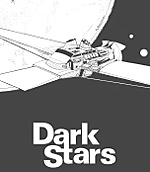
Players 1 to 4
Playing time Approximately 8 hours and up
Period Indeterminate future, at least several centuries from now
Turn scale 20 years per Interstellar turn
Map scale 2 light years per hex
Components
1 Standard cardboard box
1 unmounted, 2-color map 22"x28"
1 half-size rules booklet
255 ˝" color counters, single-sided
Counter Manifest
4 sets of 42 pieces each (green; yellow-orange; red; gray)
3 Econ markers (x1; x10; x100)
5 Dip markers (2; 1; 0; -1; -2)
20 Spacecraft pieces (numbered 1-20)
20 Markers (4xOE; 6xPE; 4xOD; 6xPD)
33 Planet markers (3xT1; 5xT2; 3xT3; 2xT4; T5; 3xG1; 5xG2; 5xG3; 4xG4; 2xG5)
18 Randomizer counters (1-6 in white; 1-6 in gray; A-F in white)
11 Blanks (2 white; 3 gray; 6 red)
SimCan says:
“Dark Stars is played on both the Interstellar and the Interplanetary level so as to place the full range of space exploration and conflict possibilities in the hands of the players .
“At the time we did Dark Stars, I played a lot of board games, but almost none of them SF because they were so bad. They routinely ignored pretty much everything having to do with astronomy, physics, and mathematics, and since my background is technical I found that hard to swallow. The main problem with just about every science fiction game I ran across was too much fiction and not enough science. We put a lot of hard science into the system’s design, simplified as much as possible to be playable, to try to put some of the science back in, rather than having it just fiction.”
Comments
Dark Stars appeared hard on the heels of sci-fi movies such as Star Wars (1977) and games such as SPI’s Freedom in the Galaxy (1979). However, DS takes a more serious and technically accurate approach to sci-fi game design. Behind the requisite and appropriately weird alien races lies a game design that is firmly grounded in hard science, with a bibliography that reads like the course syllabus of a graduate-level astronomy class. The star of the game is not a Luke Skywalker or James T. Kirk. Rather it’s the setting of the game, the Type II globular cluster system somewhat above the mass of the Milky Way.
DS tackles exploration and conquest in space, a theme that has been explored and conquered with varying success numerous times before and since. In terms of complexity and playing time, it comes close to SPI’s Outreach (1976). DS features cover art by Rodger MacGowan whose work, for a change, was less than stellar. The game graphics are rather spartan. The map, for example, is a two-color job that is stolidly utilitarian. The rule book is a very difficult read because of the incredibly dense layout of text and the dearth of examples and graphics. All this adds up to a game that takes a very long time to play, with fairly low player interaction, where details of which planets are in which orbit of each system need to be written in a log, where movement needs to be plotted for each unit, with consideration given to fuel capacity and planetary gravity, ad nauseum.
The advantages? Surprisingly, DS appears to be quite well suited for solitaire play. It can be explored at leisure, particularly because of its rigid diplomacy outcomes and simple combat resolution. The fun of the game is in experimenting with a paper laboratory that models a little cluster of stars in the vastness of space.
Collectors Notes
If not for its theme or novelty, DS may at least be a desirable collector’s item because it’s Mr. Newberg and SimCan’s only published sci-fi design, and he declares he won’t be dabbling in the genre again: “Just about all board games took us one to two years from start to publication, and DS was at the long side of that, to be expected for a complex project. Once was all I needed to get it out of my system.”
(One presumes that the Descent Operations mentioned in SimCan Newsletter No. 7 as upcoming, and never ever mentioned again, was the triumph of optimism over reality -ed)
Boone lists low, high and average prices of 5/10/7.67 at auction and 6/30/17.50 for sale.
Errata
Section B3.1 should read: “... At the conclusion of each 20 turns is a check point at which time it is determined if players have obtained their racial goals. If they have not, by mutual agreement, play may continue for another 20 turns to the next checkpoint. Each turn is composed of 4 sequenced phases...”
Clarification: Interstellar movement must be in a straight line course of the shortest possible length from the starting star system to the destination star system.
Steve Newberg says:
This is like doing Gettysburg -- you just have to try a science fiction game eventually. Our take on this topic was to minimize the fiction and up the science, so not a lot of faster-than-light travel here, just slow boats to the next star over. Over and up, by the way, since we made the star field three dimensional rather than flat. And we put in a system for creating solar systems. Spinning it up was always a bit of a thrill as you dropped in to explore a new set of planets. Four races, each with different goals and technology bases. And, if you wanted, you could fight each other!
Back to Simulacrum Vol. 3 No. 2 Table of Contents
Back to Simulacrum List of Issues
Back to MagWeb Master Magazine List
© Copyright 2001 by Steambubble Graphics
This article appears in MagWeb (Magazine Web) on the Internet World Wide Web. Other military history articles and gaming articles are available at http://www.magweb.com